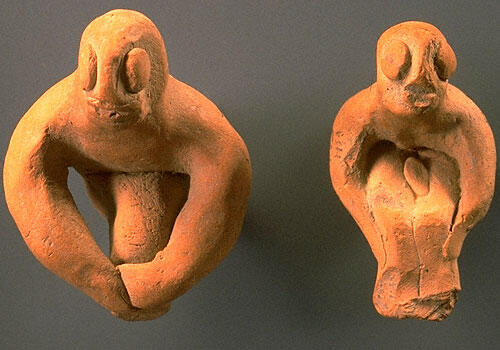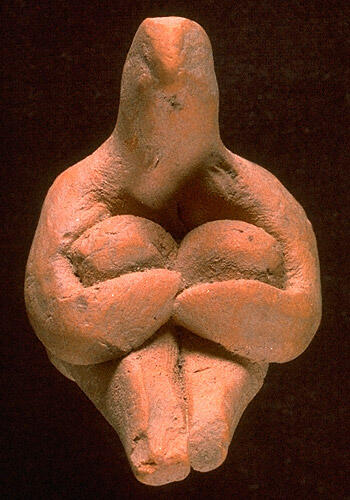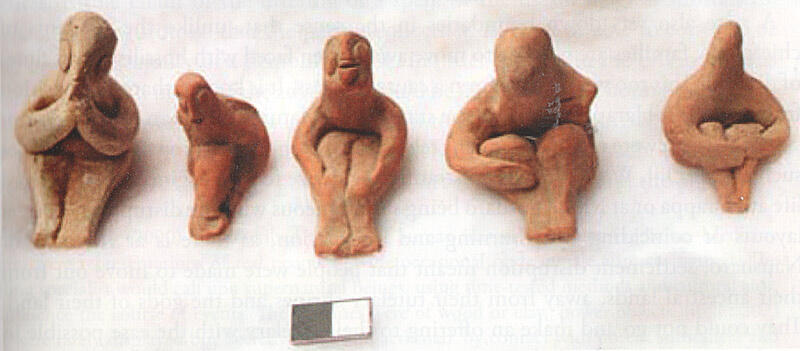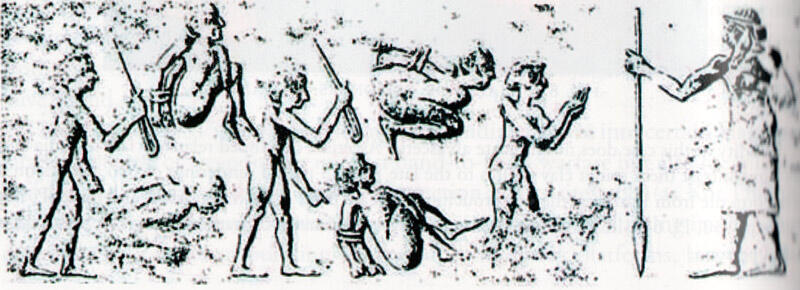January 16th, 2019
Shereen Ratnagar, in her new book The Magic in the Image Women in Clay at Mohenjo-daro and Harappa offers an interesting conjecture around a set of male figurines found at the two iconic Indus sites:
"These little figurines that I call war captives (for Kenoyer 1998:119) they are sacrificial victims) occur in number. I read the posture, the 'body language', as a statement that they have ceased to fight. S. Clark writes that that this is 'the most common type of male figurine found at Harappa.' She catalogues about 25 of them from the Harappa Museum, where she examined a total of 250 terra cotta figurines. Vats chapter on clay figurines (1940:293-4) describes 5 such pieces (plus one with a collar and legs outstretched, and another 3 of very rough workmanship. All these, except one, are from Mound F. Ardeleanu-Jansen (1993) includes only 3 in her catalogue, one of them with large appliqued eyes. She does not offer a possible identification of them.
"Depictions from Mesopotamia and Egypt of men who are clearly prisoners-of-war reinforce my interpretation. There is an Egyptian white stone statuette from the archaic period, published by K.D. Ritner (1993/2008: Fig 3b), who kneels with his hands behind his back and has no distinguishing clothes or ornaments. The figurine is perforated, suggesting it could have been hung on a string at someone's neck – which does not, however, necessarily make it the 'votive object' that Rittner believes it is.
"Bound captives are shown on a Mesopotamian Uruk-period cylinder seal, knees to the chest, arms tied together at the elbows behind the back. The figure of a king clothed in a turban and a skirt and armed with a spear dominates the scene, but there are also two armed men with sticks or clubs (Postgate 1992:24, Fig. 2.3; Hansen 2003: Fig. 7). (Fig 8.3 [Image 4]) A nude man nearest the king beseeches him whereas three bound men, arms tied behind them and their knees up against the torso, are on the ground. While Mesopotamian art does indeed show priests also to be nude, often in art and glyptic war captives are anonymous and helpless, as on the Standard of Ur.
"It needs to be emphasized that although devoid of facial features and clothes, these figurines were not mass-produced or standardized. Sizes and fabric vary, the arms are not exactly the same. Vats (1940:294) illustrated one whose palms were pressed together – it sits with legs neither fully extended nor bent up fully, 'in prayerful attitude'. (Yet he could equally be begging for mercy.) The little piece was found, together with common street garbage like sherds, metal, bone, etc., in a stratum of Mound F that overlies a stratum with not brick constructions, but three mud huts.
"None of the prisoner-of-war figurines, significantly, has the marks of deliberate shattering in antiquity, so that one may assert here that the magical rituals for which the female figurines were made are not the purpose of these crouching males. The latter belong to a separate corpus.
"Why were images of such men made? (Fig. 8.4 [Image 3]) The figurines may have been used to record that a prisoner was being placed in a state construction unit, or else produced when an official or subordinate chief – or the deracinated individual himself – came to claim a certain quantity of food for his work or upkeep. Also possible is the dedication by a warrior of a war captive to a state institution for work. As Sahlins puts it, the way to obtain a surplus (in an early state) was intensification of labour: 'getting people to work more, or more people to work'. All ancient economies, says Steinkeller, faced labour shortages (2009: 5). In Mesopotamia, war captives often became slaves or else part of the gurush work force who worked for rations (Postgate 1992: 237-8): the ration lists of Ur III may name some recipients whose personal names are non-Mesopotamian (Gelb 1973:75-6). Gelb also noted that prisoners-of-war were granted to certain temples; Steinkeller (2009) infers thus that they were distributed among the various state institutions rather than concentrated for particular objectives. The point here, however, is to underline the reality of warfare and its outcomes.
"Harappan armies could have ventured far; pastoralists and immigrants from the Kirthars or Mari Hills or Bugti Hills may have raided Mohenjo-daro and/or its surrounding cropland, carrying off grain, livestock, and perhaps also prisoners. What were the outcomes of recurring warfare for peoples newly unified in a state and recently separated by compulsory shifts of settlement (Ratnagar 1991; 2015)? Warfare leaves families broken, with widows and orphans to be cared for. A common byproduct of armed conflict is the violation of women" (Ratnagar, pp. 158-160).
What do you think? Mark Kenoyer, in the reference cited above by Ratnagar, suggests that some of the figurines may also have represented sacrificial victims "with hands and feet tied together."
Images:
1. Two seated male figurines from Harappa
2. Seated male figurine from Harappa
3. Mesopotamian cylinder seal (Figurine 8.3 in Ratnagar)
4. Several possible "prisoners of war," Mohenjo-daro (Fig 8.4 in Ratnagar)








